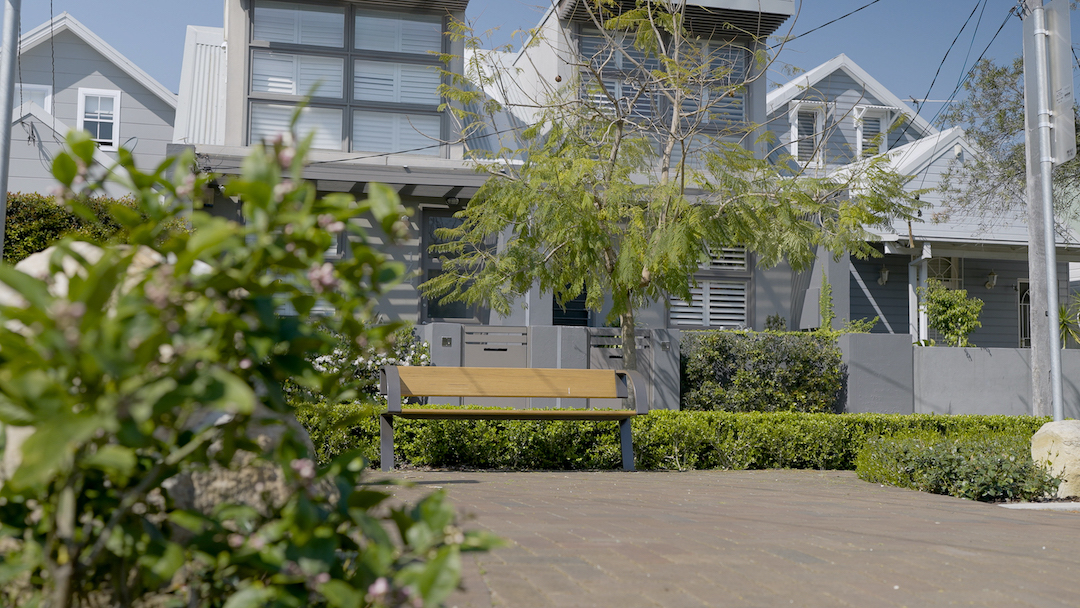Pocket parks could be the answer to increasing green space in busy cities like Sydney.
Around the country, pocket parks are being introduced as a solution to a need for more public spaces in densely populated areas. Spanning only a few hundred metres, these ergonomic parks have the potential for environmental and social benefits.

A pocket park bench in Alexandria © Jake Willis, UNSW Sydney
Going green
No matter where you live, access to green space is an important part of maintaining health and wellbeing. In fact, UNSW Senior Lecturer in urban design and landscape architecture, Dr Mike Harris, says that green areas are becoming even more vital as population size and pollution continue to grow.
“One of the issues from an urban liveability perspective is that with increasing population density, we need more public space,” he comments.
“These pocket parks are a terrific opportunity to answer that problem and to provide public space for the local community where previously there may not have been any.”
Similarly, pocket parks are the solution to an ongoing challenge; the costly and time consuming process of Introducing large parks into urban areas. For many local governments, pocket parks are a simple alternative, where smaller public spaces can be created using significantly less resources.
However, Sydney wasn’t initially designed to accommodate small scale public spaces. According to Ela Glogowska, architect and PhD candidate at the School of Built Environment, “the city has big public gestures like Centennial Park, but it wasn’t master planned to have many smaller parks in its subdivisions.”
“It’s no surprise that today we have a massive deficit of accessible public socialising areas,” she says.

A pocket park in Erskineville © Jake Willis, UNSW Sydney
Bringing the idea to life
Already, Sydney is home to several pocket parks in the inner west. They are predominantly built on underutilised land, either unsuitable for commercial buildings or reclaimed from a section of a street.
Dr Mike Harris explains that pocket parks are able to work around the infrastructure already in place. Whereas one major park needs significant space, several pocket parks can be introduced throughout a neighbourhood without much disturbance
“The idea behind pocket parks is to get more out of the space we have in cities, and the ideal place in the existing public domain is our street network.”
“Having more of these smaller pocket parks can make accessing public space more incidental and a part of daily life, rather than an event you must plan for and go out of your way to access.”
Already, several other states are encouraging communities to focus on these smaller-scale projects. In Victoria, the state government announced a program in 2020 which provided $35 million in funding for new pocket parks. It was part of their commitment to create 6,500 hectares of new greenspace across Melbourne, and improve wellbeing among communities.

A pocket park in Alexandria © Jake Willis, UNSW Sydney
Other benefits
Environmentally, pocket parks can lead to a cleaner planet. They create more shade and greenery, helping to protect the planet..
“Our urban areas are getting hotter, and we know one of the ways we can mitigate against that is through trees that have a cooling effect,” Dr Mike Harris says. “Pocket parks can help us find additional space to develop and expand the canopy cover for our cities.”
Public spaces are a social infrastructure as well. Local councils can tailor their parks to suit the needs of the community, encouraging engagement and conversation. For example, a park in a town centre may include tables for workers, whereas a park in a residential area can include play equipment for kids. Ela Glogowska believes that by providing communities with these green areas, councils can support their people.
“If we want a healthy and happy society, we need a diversity of quality public spaces for the public to enjoy, and more pocket parks will certainly contribute to that.”
To discover another project attempting to protect Australia’s ecosystems, click here.
